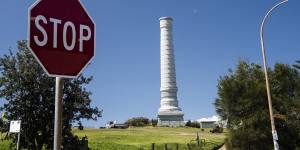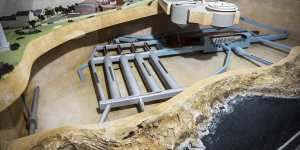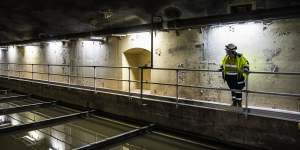The Bondi Wastewater Treatment Plant processes the effluent produced by 750,000 Sydneysiders,including the waste flushed down the CBD’s skyscrapers and restaurants. More than 150 million litres of water,fragments of COVID-19,particles of cocaine,heroin and antidepressants,and enough chemical energy to power thousands of homes flows through here each day.
What was once dumped into Sydney’s Harbour and off beaches as raw sewage is now regarded as a rich resource and a vital barometer for the city’s health.
“When COVID hit us and people couldn’t get toilet paper they used everything else that they could possibly find,” says Rebecca Yianakis,a production manager at the plant. “Bed sheets to flannelette shirts to towels … you name it,it was coming through.”
First the sewage is passed through screens to sieve out flushed flotsam.
There are tennis balls,goldfish corpses,Barbie body parts,fatberg-forming wet wipes and once,according to legend,a severed pinky finger. One day Yianakis was startled by the face of a decapitated Cabbage Patch kid smiling up at her from the muck.
Soon we’re standing above a 72-metre concrete trough filled with three million litres of filtered sludge. The surface is so silky you can peer down at your reflection,wavering from ripples set off by bubbles of toxic hydrogen sulphide gas. (The gas is hoovered up and transported to a foul air treatment chamber nicknamed The Temple of Doom.)
Fat,oil and grease rise to form a half-metre layer of scum,which is skimmed off and sent to “digesters” on top of the plant. Microbes called methanogens devour the waste and produce methane as a byproduct. The combusted gas powers the entire facility.
At the top of a set of metal stairs,there’s a crack of sunlight. We walk up and out through a door and step out onto ocean rocks. There’s a 180-degree view of the glittering Tasman Sea. The air tastes delicious.

Fifty metres below Bondi’s “poo pipe” lies Bondi Wastewater Treatment Centre. The tower allows fresh air to funnel through the facility.Steven Siewert
Waste in the waves:the deepwater outfalls that saved Sydney’s beaches
In 1990,water scientist Dr Ian Wright plunged into the surf for a race he’d never forget.
“One kilometre in,visibility went from five metres to like five centimetres,” he says. “I was a scientist at Sydney Water and I knew instantly,oh,Ian,you’re in the plume.”
It was a stormy day and the sewage from North Head,where another one of Sydney’s wastewater plants sits,had swept towards Manly beach. The water reeked.
“Now that doesn’t happen,” Wright says. “They’ve dug incredible tunnels kilometres offshore. And[the wastewater] is treated to a higher degree and discharged at depths of 80 metres.”

A model of Bondi Waste Water Treatment Centre,which opened in 1962.Steven Siewert
These deepwater outfalls resemble a row of upside-down shower heads that fritter out 150 million litres of wastewater per day.
On the ocean rocks outside the plant,the engineers point out the source of the waste that plagued Australia’s most iconic beach for decades:a small pipe dribbling into the surf that sent “Bondi cigars” and “brown-eyed mullets” bobbing past surfers.
The deep water outfalls transformed Bondi and Sydney’s other iconic ocean swimming havens. As Ceren Canbay,an engineer who moved from Turkey to live the Sydney beachside dream,tells me,“Bondi is Bondi because of us”.
There are unfortunate hangovers from the 70-year-old sewage system’s past. Three raw sewage outfalls still spew from about 10,500 households in Vaucluse,Diamond Bay and Dover Heights off Bondi’s cliffs.
A 2018 Sydney Water pollution report estimated 2000 people use the water contaminated by the outfalls for swimming,diving and spearfishing. Some consume seafood from the area including abalone and crayfish. The report characterised the public health consequences of these outfalls as “critical” and noted that on some days,a “visible plume” of sewage spreads 100 metres from the coastline.
But,on balance,the wastewater system has vastly improved the water quality of Sydney’s rivers and ocean.
Now urgent attention is being turned to how wastewater might help the city survive.
Mining the sewers:nitrogen,energy,data and water
Wastewater can be stripped of,fed into microbial fuel cells to create renewable power and spun into biosolids that can be burned for energy or used as fertiliser. Three times a year,wastewater screening provides a picture of the nation’s drug use (Sydney does double the cocaine of Melbourne and drinks one-third more alcohol).

Primary sedimentation tanks at Bondi Waste Water Treatment Plant.Steven Siewert
The COVID-19 surveillance program gave hospitals and health authorities the critical upper hand in predicting infection spikes,particularly in regional areas,and NSW Health is convening a program to test sewage for poliovirus.
But the more valuable asset of sewage is its most abundant element:water.
A recent NSW Department of Planning and Environment strategy called for urgent planning to recoup water from the state’s wastewater as the city heads for a potential shortage of 40 to 70 gigalitres of water per year.
“Compared to other Australian cities,Sydney has a low level of rainfall-independent water supply,making our city vulnerable to rapid onset and prolonged drought,” the report said,estimating 93 per cent of wastewater is used once before its ejection out to sea.
The political will to discuss recycled wastewater is low while dams are full,says Wright. But the droughts will come,probably in increasing intensity due to climate change,potentially pushing the city’s water sources to the brink.
“It’s actually cheaper and easier to treat sewage to create drinking water than it is to remove the salt from oceanic water,” says Wright. And while people might grimace at the thought of drinking sewage-sourced water,he points out that,to a degree,we’re already doing it.
In north-western Sydney,where Wright lives in Richmond,water is drawn from the Hawkesbury River.
“Upstream,there are seven or eight sewage treatment plants. I calculated that the raw water used for our drinking water in northwestern Sydney was probably about 20 to 25 per cent treated sewage.”
“The common rhetoric in London is that people have drunk water that filtered through seven sets of kidneys because sewage goes into the river and the next town extracts it. Well,we’re doing it far more than the English. And I think it’s the way of the future.”
The Morning Edition newsletter is our guide to the day’s most important and interesting stories,analysis and insights..